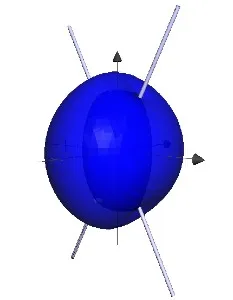
Physics 208
Class material from Physics 208 "Electrooptics" at San Jose State for Spring 2009. This podcast will mostly contain recorded lectures in m4a format.
- Update frequency
- every 4 days
- Average duration
- 71 minutes
- Episodes
- 20
- Years Active
- 2009

4 wave mixing
We look at the third order nonlinear effect and uses for Kerr lenses.
01:18:41 |
Thu 30 Apr 2009

Nonlinear Wave Equation
We use coupled mode analysis to investigate the field amplitudes in three wave mixing, and look at the effect of phase mismatch on the conversion efficiency of nonlinear processes.
01:13:44 |
Thu 23 Apr 2009

Phase Matching of SHG
We look at the phase matching condition for Second Harmonic Generation and also do a tuning curve example for an OPO
01:09:35 |
Tue 21 Apr 2009

Nonlinear optics 1
We introduce non-linear optics and discuss various forms of 3 wave mixing including frequency converters, optical parametric amplifiers (OPAs), optical parametric oscillators (OPOs) and second harmon…
01:13:05 |
Thu 16 Apr 2009

2D Waveguides
We generalize the expressions for 1D waveguide to 2 dimensions and focus on the calculation of power coupled into a waveguide from a Gaussian beam.
01:14:30 |
Tue 14 Apr 2009

1D waveguides
We look at both the ray picture and field picture of modes in a 1D waveguide.
01:12:46 |
Tue 07 Apr 2009

Photonic Crystals
We look at the unusual properties of 2d and 3d photonic crystals
01:12:05 |
Thu 02 Apr 2009

Propagation in periodic media
We look at Bloch Wave solutions to propagation in a periodic material using Fourier analysis of the material permittivity.
01:05:59 |
Tue 31 Mar 2009

Electrooptics
We introduce the electrooptic tensor and do examples using the linear electrooptic effect.
01:03:05 |
Tue 03 Mar 2009

Acoustooptic devices
We look at figures of merit for acoustooptic materials and limitation on modulation bandwidth in acoustooptic modulators.
00:53:53 |
Thu 26 Feb 2009

Acoustooptics
We look at the Bragg condition in anisotropic materials and solve for the diffracted beam amplitude using coupled mode theory.
01:08:50 |
Tue 24 Feb 2009

Jones Calculus and Liquid Crystals
We introduce Jones calculus to keep track of polarization direction and use it to describe a number of examples including polarization rotation in a twisted nematic liquid crystal.
01:15:57 |
Tue 17 Feb 2009

Faraday Rotators in LIGO
We look at how aspects of this class relate to the Laser Interferometer Gravitational Wave Observatory (LIGO) and investigate the design of the LIGO Faraday Isolators
00:59:18 |
Thu 12 Feb 2009

Optical Activity
We provide a physical description for the origin of optical activity and faraday rotation in a material and useeigenmodes as well as coupled mode analysis to solve for the behavior of fields propagat…
01:17:14 |
Tue 10 Feb 2009

Index Ellipsoid
We introduce the index ellipsoid and show how it can be used to find the indices of refraction for light propagating in a crystal in an arbitrary direction.
01:18:52 |
Thu 05 Feb 2009

Propagation in Anisotropic Materials
We look at solutions to the wave equation in anisotropic materials and the "normal shells" that describe of those solutions.
01:16:32 |
Tue 03 Feb 2009

Maxwell's Equations in Matter
We consider Maxwell's equations in matter and use them to find the boundary conditions at an interface, and the wave equation in anisotropic materials.
01:16:59 |
Thu 29 Jan 2009

Waves in Isotropic Materials
We derive the wave equation in isotropic materials from Maxwell's laws and we introduce phasor notation as a method for simplifying calculations.
01:11:00 |
Tue 27 Jan 2009
Disclaimer: The podcast and artwork embedded on this page are the property of Peter Beyersdorf. This content is not affiliated with or endorsed by eachpod.com.